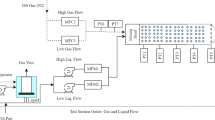Abstract
To predict local interfacial area in a packed bed under the trickling flow, a wavy annular flow model was developed by introducing the shape of waves in a thin liquid film. The trickling flowin a packed bed was approximated by an annular flow through a number of equivalent channels in which the continuous gas and liquid were completely separated by a wavy interface. Film thicknesses were measured by parallel wire probes to estimate the wave structure on the interface. By integrating the interfacial areas over a certain time period, the time-averaged local interfacial area was evaluated from a low to high interaction flow regime: 1) from trickling to bubbly flow and 2) from trickling to pulsing flow. The interfacial area predicted by the wavy annular flow model in the trickling flow was moderately higher than those predicted with the empirical correlations developed by others. The results show that the interfacial area increases more significantly as the flow regime changes from trickling to pulsing flow than that increases as the flow regime changes from trickling to bubbly flow. As a result, the wave structure on the interface should be considered to predict more accurate interfacial area in a packed bed.
Similar content being viewed by others
References
K. M. Ng, A model for flow-regime transitions in cocurrent down-flow trickle-bed reactors, AIChE Journal, 32 (1986) 115–122.
F. Larachi, M. Cassanello, A. Laurent, N. Midoux and G. Wild, Gas-liquid interfacial areas in three-phase fixed bed reactors, Chemical Engineering and Processing, 36 (1997) 497–504.
N. Midoux, B. I. Morsi, M. Purwasasmita, A. Laurent and J. C. Charpentier, Interfacial area and liquid side mass transfer coefficient in trickle bed reactors operating with organic liquids, Chemical Engineering Science, 39 (1984) 781–794.
R. G. S. Venkata, N. D. Venkata and Y. B. G. Varma, A correlation for interfacial area in co-current gas-liquid downflow through packed beds, Bioprocess Engineering, 10 (1994) 53–59.
I. Iliuta, F. Larachi and M. H. Al-Dahhan, Double-Slit model for partially wetted trickle flow hydrodynamics, AIChE Journal, 46 (2000) 597–609.
S. T. Revankar, Pore scale model for flow regime transition in a trickle bed reactor, Chem. Eng. Comm., 184 (2001) 125–138.
A. Attou and G. Ferschneider, A two-fluid hydrodynamic model for the transition between trickle and pulse flow in a cocurrent gas-liquid packed-bed reactor, Chemical Engineering Science, 55 (2000) 491–511.
E. J. Molga and K. R. Westerterp, Experimental study of a cocurrent upflow packed bed bubble column reactor: pressure drop, holdup, and interfacial area, Chemical Engineering and Processing, 36 (1997) 489–495.
B. J. Motil, V. Balakotaiah and Y. Kamotani, Gas-liquid two-phase flow through packed bed in microgravity, AIChE Journal, 49 (2003) 557–565.
B. I. Morsi, N. Midoux, A. Laurent and J. C. Charpentier, Hydrodynamics and interfacial areas in downward cocurrent gas-liquid flow through fixed beds. Influence of the nature of the liquid, International Chemical Engineering, 22 (1982) 142–151.
G. Kocamustafaogullari and M. Ishii, Foundation of the interfacial area transport equation and its closure relations, Int. J. Heat Mass Transfer, 38 (1995) 481–493.
S. Kim, Interfacial area transport equation and measurement of local interfacial characteristics, Ph.D. Thesis, Nuclear engineering at Purdue University (1999).
X. Sun, Two-group interfacial area transport equation for a confined test section, Ph.D. Thesis, Nuclear engineering at Purdue University (2001).
I. F. Macdonald, M. S. El-Sayed, K. Mow and F. A. L. Dullien, Flow through porous media: the Ergun equation revisited, Ind. Eng. Chem. Fundam., 18 (1979) 199–208.
K. Grosser, R. G. Carbonell and S. Sundaresan, Onset of pulsing in two-phase concurrent downflow through a packed bed, AIChE Journal, 34 (1988) 1850–1860.
S. T. Revankar, H. Olenik, D. Jo and B. Motil, Local instrumentation for the investigation of multi-phase parameters in a packed bed, Proceedings of Institution of Mechanical Engineering, Part E: Journal of Process Mechanical Engineering, 221 (2007) 187–199.
R. W. Swanson, Characteristics of the gas-liquid interface in two-phase annular flow, Ph.D. Thesis, University of Delaware (1966).
Author information
Authors and Affiliations
Corresponding author
Additional information
Daeseong Jo is an assistant professor in the School of Mechanical Engineering at Kyungpook National University. He received his Ph.D. degree in nuclear engineering from Purdue University, M.S. degree in aerospace engineering from Purdue University, and B.S. degree in mechanical engineering from University of Connecticut. His research interests are two-phase flows, phase change during boiling and condensation, heat transfer, and nuclear safety.
Rights and permissions
About this article
Cite this article
Jo, D. Hydrodynamic model of interfacial area for trickling flow in a packed bed. J Mech Sci Technol 30, 171–178 (2016). https://doi.org/10.1007/s12206-015-1220-9
Received:
Revised:
Accepted:
Published:
Issue Date:
DOI: https://doi.org/10.1007/s12206-015-1220-9




